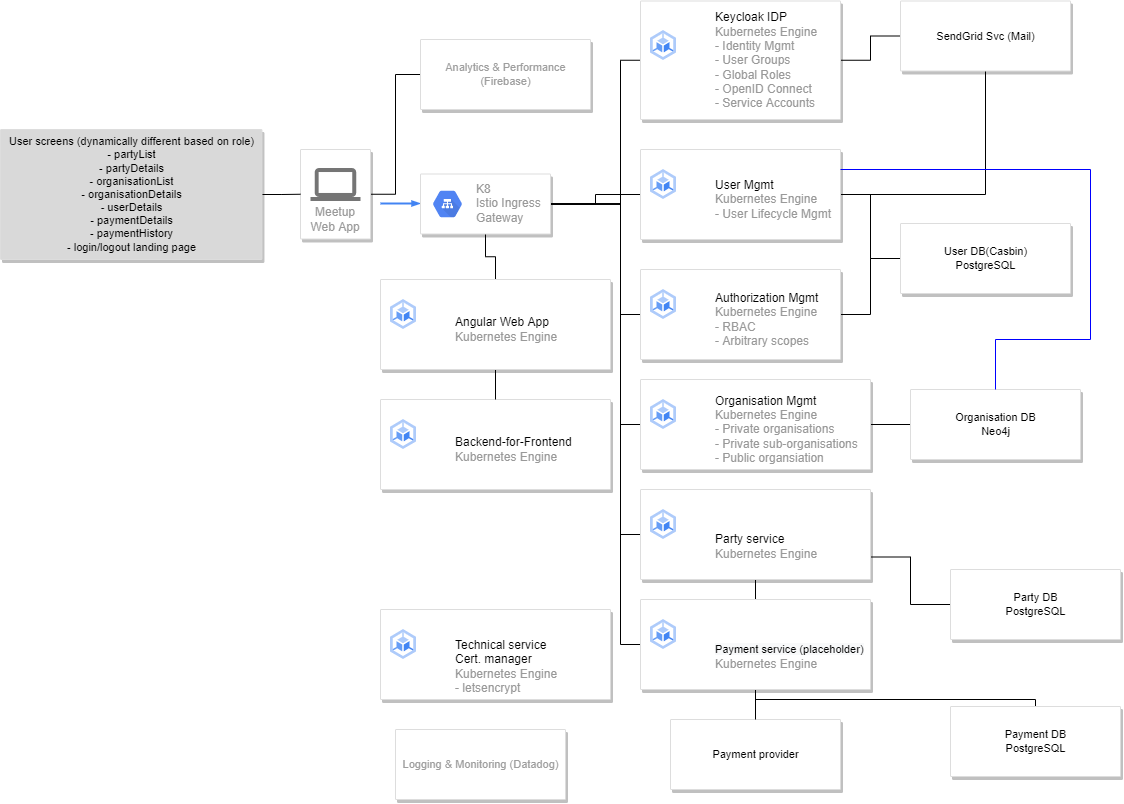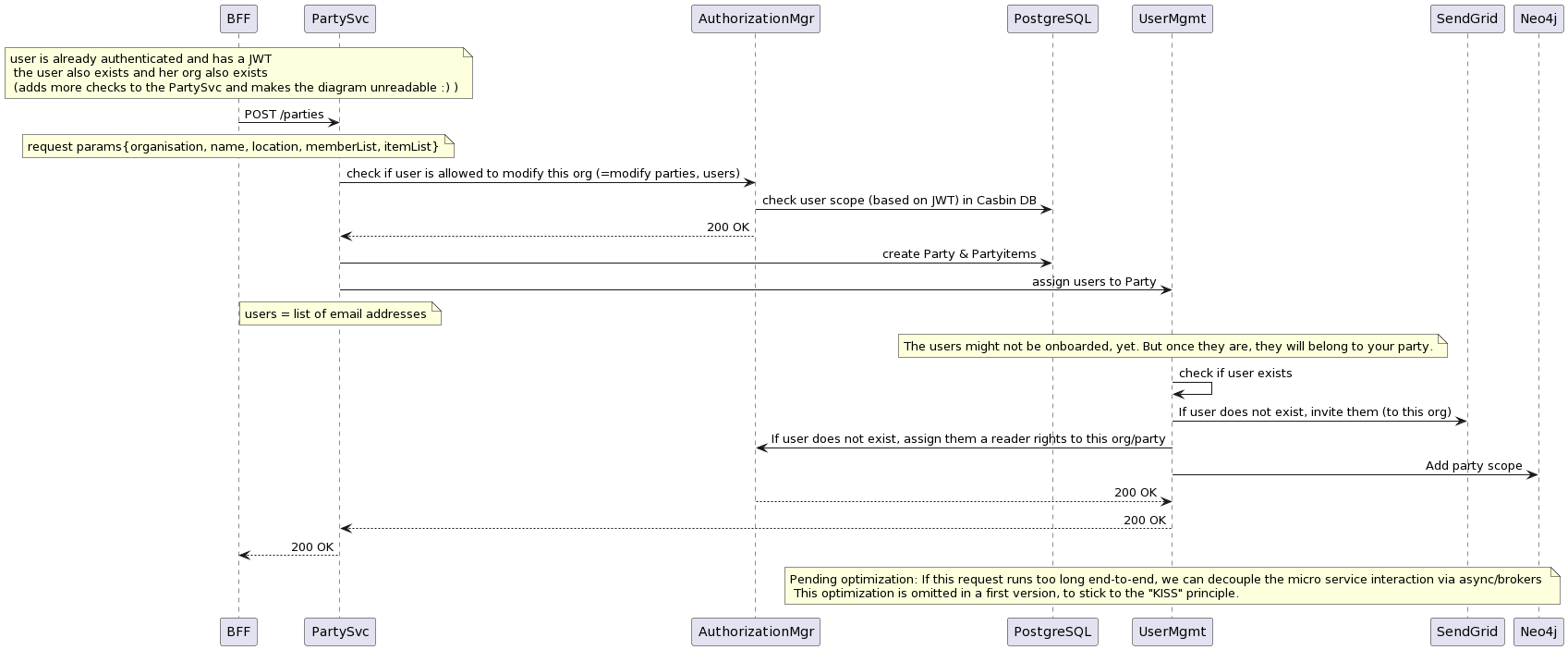Meetingz system
Architecture overview
Design choices
- Cloud provider: GCP (for price / skill reasons)
- Programming languages:
- Node frontend, Angular
- reason: wide adoption, easy to find skill able to build in Angular
- Java for backend
- reason: skill set of TPO (=me :) ); very wide adoption
- "heaviness" of Java is starting to get addressed with recent frameworks (e.g. Quarkus)
- good alternative: upskilling TPO and using NodeJS to leverage optimal team efficiency / learning curve / infrastructure harmonization
- Terraform for IaC
- Programming style: test driven development (TDD)
- Culture: Agile (Kanban) + deliberate care modes;
- Design choices:
- Custom build:
- I've chosen to build a custom system, since this is what I'm familiar with for a web app. This stack optimizes for fine-grained control down the line (e.g. adding features) and integrateability into an enterprise context.
- Alternatives considered:
- Given more time, I'd check out more as-a-service based options that save on complexity and development time. For example, due to the payments requirement, it could be worth while to look into Shopify.
- Keycloak + own user mgmt:
- Allows for easy future flexibility (e.g. such as offering the service to private organisations / existing systems later on)
- Good alternative: Using User Management completely as a service (e.g. frontegg.com)
- using such a service would be faster, more expensive and potentially block some integrations later on
- Organisation Mgmt:
- Allows for multi-tenant setup of private parties (e.g. forming of groups); Alternative would be to have all private parties just belonging to the creator.
- Monitoring: Datadog
- Is expensive, but very convenient to use
- Good alternative: Self-host Kiali, prometheus, jaeger, grafana as a cheap alternative (with more development & operating cost)
- Not so good alternative: Cloud provider's native monitoring tools
- Persistence
- Neo4j for organisation setup, to add flexibility to future changes
- PostgreSQL for users, since this is well suited to SQL/ACID DBs
- PostgreSQL for parties and most this related: the clear structure of parties also match nicely to classic RDBMS solutions
- Payment service placeholder
- Adding a payment service is likely a solved problem and there are SaaS offerings to just use. However, I did take a shortcut here in the design and just assume that we would solve this later. For now a micro service just handles payments :)
- e-Mail sending via sendgrip
- cheap and quick option to get started, especially when used with custom domain
- not added components
- CDN: could be added if users are highly distributed and/or larger media is used
- Queue / Broker pattern: in a simple version, synchronous service-to-service calls can be used to make sure that actions are fully executed
- exception: Depending on the contract between payment service and payment provider we might want to add a queue here. The reason is that this process is longer running and must not fail.
- DevOps stack: Azure DevOps Pipelines
- reason: existing assets for pipelines :)
- good alternative: gitlab, github actions
- Custom build:
Roadmap & timeline
Requirements prior to starting development work at all
- Business strategy well formulated
- Timeline & hiring strategy formulated
- Organisational setup complete (e.g. legal, payment, etc.)
- Test user group at hand
Phase 1: Testing UIX assumptions & prepare scale-up (~3 months)
- Organisational tooling
- Screen software (e.g. Invision)
- Jira setup
- Meeting tooling
- User experience design
- Including (most basic) screens
- Building only frontend app with mocks / clickdummy in order to help test UIX and feature demand
- Finishing technical architecture overview
- Start preparing "agnostic" infrastructure
- Onboarding guidelines for new-hires
- Cloud infrastructure settings
- dev / prod environment setup (manually)
- roles & rights setup on Cloud
- payment & reporting setup
- first automation features (e.g. CI/CD)
- minimum CI/CD for services (with public workers)
- review process
Phase 2: MVP to test & develop user interest with public parties (no revenue) ~3 months
- mimimum automation features (e.g. CI/CD)
- code quality measures
- container scans
- linting
- library scans
- test automation
- core part of the system
- user management
- organisation of meetings
- only public parties
- core "catchy" feature: What each one brings to the party
Phase 3: Hardening & Private parties beta ~3 months
- SEO optimisation
- CI/CD for infrastructure (IAC)
- Quality improvements / removal of technical debt
- Test environment setup (manually)
- Private parties (for limited beta user group)
- Security review
- Adding more features based on user demand
Phase 4: Payments & more feature add ~3 months
- Private parties as general availability feature
- Adding payments solution
- Adding simple operations processes for private parties
- ... more features ...
Team composition & budget
- note: The team composition heaviliy impacts the timeline. Since no goal was defined regarding when to release what specific feature set, this composition is somewhat arbitrary
roles
- business & design roles
- product owner (PO) & product manager (PM) (1 FTE): (1200€/day)
- PO: Responsible for the features of the product & validating the deliverables
- PM: Responsible for setting up wide-scale business plan, including sales & marketing, future business deals, roadmap-level features
- technical product owner / lead engineer (TPO): (1200€/day)
- senior frontend engineer (900€/day)
- junior frontend engineer (700€/day)
- senior backend engineer (900€/day)
- ideally has DevOps experience as well
- junior backend engineer (700€/day)
- senior agile coach (1200€/day)
complementariy / at-request roles
- security expert (1400€/day)
- seo / marketing expert (1000€/day)
- designer (1000€/day)
- senior architecture expert (VC service or 1600€/day)
- senior business case expert (VC service or 2500€/day)
budget planning
- note: Budget planning does only reflect a *plan* for the budget. Actual salaries may differ entirely (e.g. because there is a flat salary for all :) )
Phase 1 (3 months):
- 1 FTE designer => UIX
- 1/2 FTE senior frontend engineer (second half) => onboarding & dummy screens
- 1/2 FTE senior backend engineer (second half) => onboarding & helping infrastructure setup
- 1 FTE PO/PM => UIX & backlog creation
- 1 FTE TPO => infrastructure setup, technical design & backlog creation
- 1/2 FTE Senior agile coach => way-of-working setup & backlog creation
- 5 days senior architecture expert (for review workshops)
- 5 days senior business case expert (for review workshops)
Phase 2 (3 months):
- changes to previous phase
- scale down designer to 1/4 FTE => because initial UIX should nearing it's finish
- scale up full engineering team
- 2 frontend engineers (senior + junior)
- 2 backend engineers (senior + junior)
- TPO
- scale down to 1 day: senior architecture expert (for PI change)
- scale down to 1 day: senior business case expert (for PI change)
Phase 3 (3 months):
- changes to previous phase
- one time spent: 10 days security expert
- scale down designer to 0 FTE / ad-hoc work
Phase 4 (3 months):
- same as phase 2
Comments
Here's my timeboxing approach:
- 3.5h architecture design (as suggested)
- 30min sketching what to implement (=> basic party svc API)
- 4h coding
- out of which I had 2.5hrs fighting the dev machine setup (ended up re-installing Docker)
- left with ~1.5hrs I decided not being able to finish anything useful and to focus on the design
- some cases to showcase TDD
- writing comments to outline the code, to instead touch on things I care about in the code
- async programming style
- mocking / separation of IT and unit tests
- proper POJO modeling
Usage
Running docker compose up -d should be all that's required. Just there is not much to run...
In the docker compose, there is still a bug that makes quarkus refuse to build.
Manually it builds fine:
docker build -f be-service-partyplanner/src/main/docker/Dockerfile.jvm -t quarkus/be-service-partyplanner-jvm be-service-partyplanner/.

